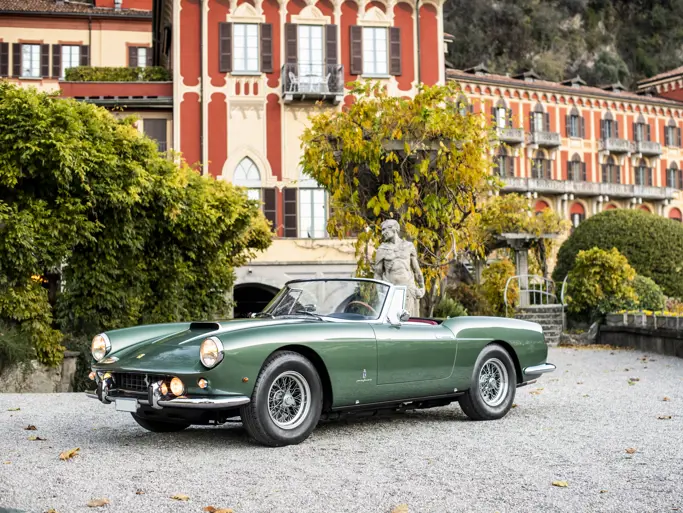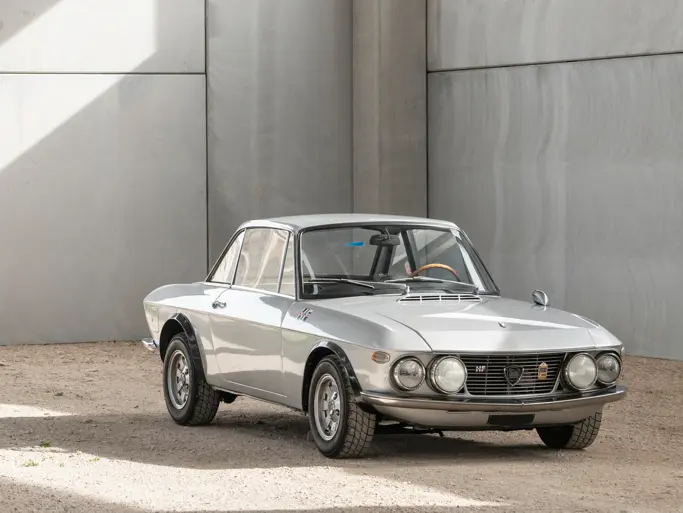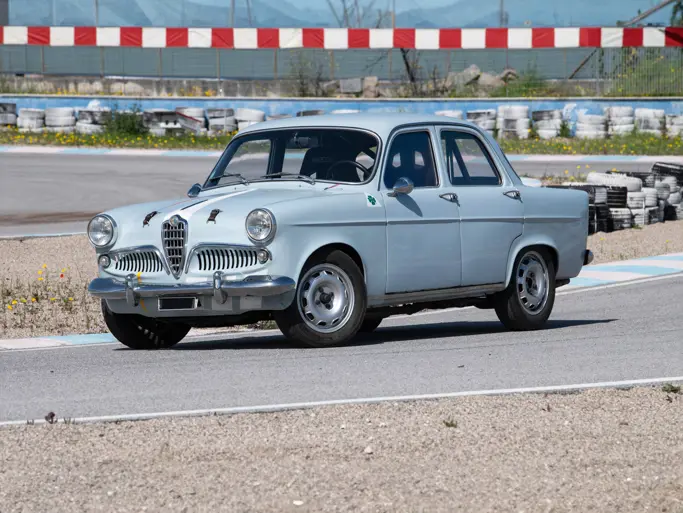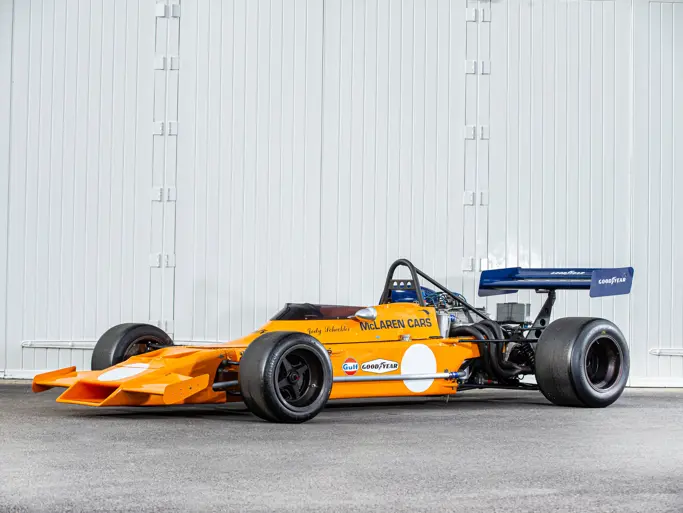Paris 2015
1966 Lamborghini 400 GT 2+2 by Touring
{{lr.item.text}}
€476,000 EUR | Sold
 | Paris, France
| Paris, France
{{internetCurrentBid}}
{{internetTimeLeft}}

- One of only 247 produced
- Recent restoration in beautiful colours
- A fine Italian GT
- Seulement 247 exemplaires produits
- Restauration récente dans des teintes superbes
- Magnifique GT italienne
320 hp, 3,929 cc DOHC 60-degree V-12 engine, five-speed all-synchromesh transmission, independent front and rear suspension with unequal length wishbones, coil springs, and anti-roll bars, and four-wheel Girling disc brakes with servo-assist. Wheelbase: 2,550 mm.
Moteur V-12 à 60°, 3 929 cm3, 320 ch, deux ACT par banc, boîte cinq rapports synchronisés, suspension avant et arrière indépendante par triangles inégaux, ressorts hélicoïdaux et barres antiroulis, freins à disques Girling sur les quatre roues, assistance. Empattement: 2 550 mm
Ferruccio Lamborghini was a hugely successful tractor and air-conditioning manufacturer, and as legend has it, after being spurred on by a disagreement with Enzo Ferrari over his 250 GT, he decided to produce his own GT car. As Lamborghini was extremely wealthy, finding the resources to build this car was not an issue, and he was able to display his first prototype, the breath-taking 350 GTV which had been styled by Carrozzeria Touring of Milan, to the world at Turin in November 1963. The first model offered to the public was the 350 GT, which was adapted from the show car design by Touring for serial production. It appeared at Geneva in March 1964, wearing a sensational aluminium-alloy Superleggera body that was produced by Marazzi. The car was unique when compared to Ferraris and Maseratis of the period, with its distinctive design, which earned rave reviews, excellent V-12 performance, and superb handling, which came courtesy of engineer Giotto Bizzarrini (the “father” of the legendary Ferrari 250 GTO).
Two years later, this car evolved into the 400 GT 2+2, which featured additional vestigial rear seating and subtle styling alterations but remained on the same wheelbase. Whilst the style of the 350 GT was preserved, virtually every panel had been revised and quad headlamps were added. The floor pan was lowered, the roof was raised, and additional interior room was made possible by reversing the upper and lower control arms in the front of the rear suspension arrangement. Most importantly, the 3.5-litre V-12 engine was increased to four litres, resulting in an increase in horsepower to a substantial 320. All-around suspension was via double wishbones with four-wheel disc brakes, and the car also included a Lamborghini-built five-speed gearbox that was designed by Gian Paolo Dallara, which replaced the earlier ZF-derived unit and was considered to be superior by aficionados.
Only 247 Lamborghini 400 GTs were manufactured between 1966 and 1968, and amongst them was the car offered here, chassis number 0646. According to information obtained from the Lamborghini factory, it was completed on 8 June 1966 and originally finished in Silver Grey with a black interior. This factory information also notes that the car was prepared for the Swiss market with a tinted blue windscreen and backlight and that the original engine was number 0594, which is still present today. The finished 400 GT was delivered to dealer Garage Foitek, of Zürich, on 8 November 1966, and it likely found its original owner in the country that winter.
Today, thanks to a recent complete and extensive European restoration, the car presents beautifully in a rich dark grey hue, with its buttery tan leather interior in wonderful condition and a well-detailed engine bay. The wheels are Borrani chrome wire wheels with three-eared knock-off hubs, which have been polished and shod in Pirelli P4000 tyres. A spare is included in the boot, but it is not in road-worthy condition. No chips or stone damage are present, and the car appears to have had its chrome work freshly polished and the seals recently replaced. Under the bonnet, all appears fresh and well-detailed, and the power windows work properly. The car has recorded 2,040 kilometres, which have most likely been accumulated since restoration.
This beautiful 400 GT 2+2, which has been described by an RM specialist as being “a clean car with a lovely feel”, is ripe for driving enjoyment.
Ferruccio Lamborghini était un constructeur de tracteurs et de systèmes d'air conditionné dont l'activité était florissante lorsque, comme l'indique la légende, il connut un léger conflit avec Enzo Ferrari à propos de sa 250 GT et a donc décidé de produire sa propre voiture de Grand Tourisme. Étant extrêmement aisé, les ressources n'étaient pas un problème pour Lamborghini et, au Salon de Turin de novembre 1963, il exposait au monde entier son premier prototype, l'extraordinaire 350 GTV, dessinée par la Carrozzeria Touring, de Milan. A la suite de cela, le premier modèle commercialisé fut la 350 GT, adaptée pour la série à partir du prototype du Salon. Elle était dévoilée au Salon de Genève de 1964, avec une sensationnelle carrosserie Superleggera en aluminium fabriquée par Marazzi. Comparée aux Ferrari et Maserati de cette époque, elle était vraiment unique ; sa forme s'attirait les louange de la presse, de même que la puissance de son V12 et son excellent comportement, obtenus grâce aux travaux de l'ingénieur Giotto Bizzarrini (le « père » de la légendaire Ferrari 250 GTO).
Deux ans plus tard, cette voiture connaissait une évolution avec la 400 GT 2+2, qui bénéficiait d'une toute petite banquette arrière grâce à de subtiles modifications de forme, sur le même empattement. Le style de la 350 GT était préservé, mais pratiquement tous les panneaux de carrosserie avaient été revus et la calandre s'entourait de quatre phares. Le plancher était abaissé, le toit rehaussé et certains éléments de suspension étaient inversés pour permettre d'agrandir l'espace intérieur. De plus, la cylindrée du V-12 de 3,5 litres passait à 4 litres, ce qui provoquait une augmentation de puissance, avec une valeur généreuse de 320 ch. La suspension comportait des doubles triangles à l'avant et à l'arrière et les freins étaient à disque. La voiture recevait une boîte de vitesses Lamborghini cinq rapports conçue par Gian Paolo Dallara, qui remplaçait la transmission ZF et que les aficionados considéraient comme meilleure.
La production de Lamborghini 400 GT s'est limitée à 247 exemplaires entre 1966 et 1968. La présente voiture, châssis n°0646, en fait partie. D'après les informations fournies par Lamborghini, elle est sortie d'usine le 8 juin 1966. Elle était de teinte gris argent avec intérieur noir et les archives précisent qu'elle avait été préparée pour le marché suisse, avec un pare-brise teinté et un phare de recul, et qu'elle était équipée du moteur n°0594, ce qui est encore le cas aujourd'hui. Elle a été livrée neuve le 8 novembre au distributeur de Zurich le Garage Foitek, et a sans doute rejoint son premier propriétaire cet hiver-là dans ce même pays.
Aujourd'hui, grâce à une restauration complète et récente en Europe, cette voiture est magnifique dans sa teinte gris foncé, avec une sellerie beurre frais en superbe état et un compartiment moteur impeccable. Les jantes sont des Borrani chromées à rayons avec papillon à trois branches, chaussées de pneus Pirelli P4000 ; une roue de secours est rangée dans le coffre, mais n'est pas utilisable telle quelle. La peinture ne présente pas de choc ni d'éraflure, les chromes ont été récemment astiqués et les joints soigneusement remplacés. Sous le capot, tout est propre et de présentation soignée. Les vitres électriques fonctionnent correctement. Cette voiture affiche 2 040 km, très probablement depuis sa restauration.
Décrite par un spécialiste RM comme étant « une voiture saine offrant de bonne sensations », il s'agit d'une superbe 400 GT 2+2, prête pour offrir le plaisir de conduire.




